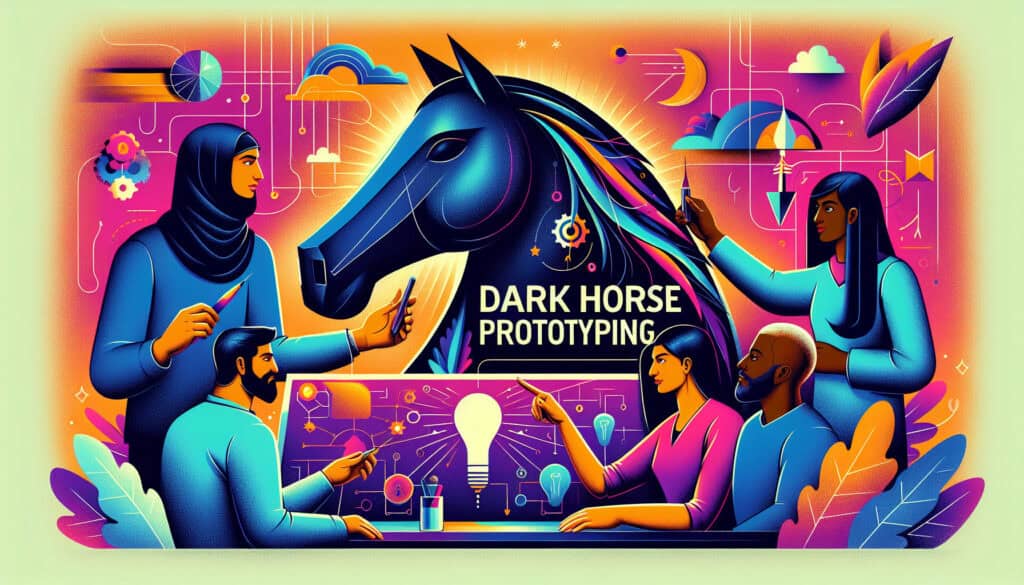A technique where a team deliberately develops a provocative, unconventional, and seemingly unworkable prototype alongside more conservative options.
- 方法: 精益西格玛, 制造业
Dark Horse Prototyping

Dark Horse Prototyping
- 敏捷方法论, 集思广益, 创造力, 跨职能协作, 设计思维, 创新, 原型设计, 快速原型制作, 以使用者為中心的設計
目标
如何使用
- In an innovation process, a 'dark horse' or 'wild card' idea is prototyped to challenge assumptions, push creative boundaries, and explore the fringes of the problem space, even if it's not expected to be the final solution.
优点
- Stretches the team's creativity and pushes them beyond safe solutions; can lead to breakthrough innovations by exploring radical ideas; helps to clarify the boundaries of the solution space.
缺点
- The prototype is often impractical and has a low chance of direct success; can be seen as a waste of resources if the purpose is not understood; may be too abstract for some team members.
类别
- 构思, 产品设计
最适合:
- Challenging assumptions and sparking innovation by prototyping a radical, high-risk, and unconventional idea.
Dark Horse Prototyping finds its value in diverse sectors such as automotive design, consumer electronics, and 医疗器械 development, where teams are encouraged to break free from traditional paradigms and explore uncharted territories of product conceptualization. This methodology is particularly relevant during the early phases of innovation projects when teams are ideating potential solutions, as it allows them to formulate and visualize unconventional concepts that may initially seem impractical or risky. Participants often include cross-disciplinary teams comprised of designers, engineers, marketers, and end-users, ensuring diverse viewpoints that challenge established norms. By creating tangible representations of these ‘wild card’ ideas, organizations can facilitate discussions that refine understanding of the problem space and identify potential barriers to innovation. Companies like IDEO and Google X have successfully utilized this methodology to experiment with ideas like driverless cars and advanced robotics, showing how redefining the boundaries of what is possible can lead to technological breakthroughs. By encouraging a culture that values radical thinking, Dark Horse Prototyping becomes a platform for inspired creativity, propelling teams to interrogate their assumptions and discover innovative pathways that conventional approaches might overlook. This method demonstrates that even ideas initially perceived as impractical can serve as catalysts for discussion, ideation, and, eventually, development of products that address futurist needs and markets.
该方法的关键步骤
- Identify a 'dark horse' idea that diverges from conventional solutions.
- Develop a low-fidelity prototype to visualize the concept quickly.
- Conduct rapid testing with users to gather immediate feedback.
- Analyze feedback to understand user perceptions and potential challenges.
- Iterate on the prototype based on user input, refining the idea further.
- Explore adjacent concepts that may emerge during prototype iterations.
- Document findings to inform future design directions and innovation strategies.
专业提示
- Utilize scenario planning techniques to envision extreme use cases and their implications on the problem space.
- Engage diverse stakeholder perspectives during prototyping sessions to uncover hidden assumptions and 偏见.
- Implement rapid iteration cycles to refine dark horse concepts based on real-time feedback and exploration.
历史背景
1949
1950
1950
1960
1960
1960
1960
1940
1950
1950
1958
1960
1960
1960
1960
(如果日期不详或不相关,例如 "流体力学",则对其显著出现的时间作了四舍五入的估计)。















相关文章
制造运营管理(MOM)
制造执行系统(MES)
生产控制计划
人工测试
手动搬运评估表 (MAC)
手动任务风险评估工具(ManTRA)